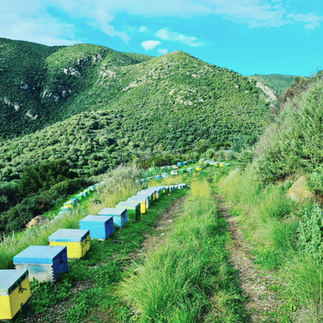How Provenance Shapes the Food We Love: Olive Oil and Honey in Regional Cooking
- daisyneal
- Oct 3
- 2 min read
When I started learning more about olive oil and honey, I realised something important: these ingredients don’t just add flavour to food, they actually shape entire cuisines. The character of an oil or honey is tied so closely to where it comes from that it influences the way people cook, and even the dishes a country becomes known for.
Take olive oil, for example. We often lump it all together, but the taste of Greek, Spanish, and Italian oils is so different that it’s no surprise their cooking traditions have developed around them.
Greek Olive Oil: Bold and Peppery
Greek olive oil is usually intense. peppery, grassy, sometimes with that little tickle at the back of your throat. It’s full of polyphenols (antioxidants), which give it that punch. Greek cooking doesn’t shy away from strong flavours, so the oil fits right in.
Think of a classic horiatiki salad: ripe tomatoes, cucumber, olives, and feta. The oil is poured generously, not just to dress the salad but to stand on its own. Or grilled vegetables and wild greens (horta)- the olive oil is the seasoning. That boldness is part of the national palate, and it comes directly from the groves.
Spanish Olive Oil: Soft and Fruity
Spanish olive oil is usually softer and fruitier, sometimes with a nutty roundness. It makes sense, then, that Spanish food often leans into the sweet-savoury balance. Pan con tomate is the perfect example: good bread rubbed with tomato, then drenched in fruity oil. It’s simple, but the oil is what makes it sing.
That gentler profile also works beautifully for frying tapas dishes- croquetas, calamari, even churros. The oil doesn’t overwhelm; it complements smoky paprika, rich hams, and bold spices that Spanish cooking loves.
Italian Olive Oil: Fresh and Aromatic
Italian oils often have a bright, grassy freshness. They’re the kind of oils that taste “green”, lively and fragrant. Italian food has a deep respect for balance and letting ingredients shine, so this style of oil is perfect.
Drizzle it over a Caprese salad, finish a bowl of pasta, or dress bitter greens- the oil adds lift without taking over. Even in baking, Italians sometimes use olive oil for cakes, where that light fruitiness adds depth without heaviness.
Honey and Its Regional Character
Honey is another example where provenance shows up clearly on the plate. Bees carry the flavour of the landscape into every jar.
Greek Thyme Honey: Strong, herbal, and slightly resinous. It’s no wonder it shows up with yogurt, cheeses, and in loukoumades (those little honey-soaked doughnuts). The honey’s boldness matches the intensity of Greek desserts and dairy.
English Wildflower Honey: Soft and floral, more delicate. It finds its place in teas, porridge, and simple baking.
Why Provenance Matters
None of this is a coincidence. People have always cooked with what they had around them, and over generations, the flavours of local olive oil and honey became part of the identity of their cuisine. Peppery oil leads to bold salads and grilled vegetables. Citrus honey leads to bright, glossy pastries. Delicate honey leads to comforting teas and cakes.
Provenance isn’t just about knowing where food comes from. It’s about understanding why Greek food tastes Greek, or Spanish food tastes Spanish. The land has written itself into the recipes.























Comments